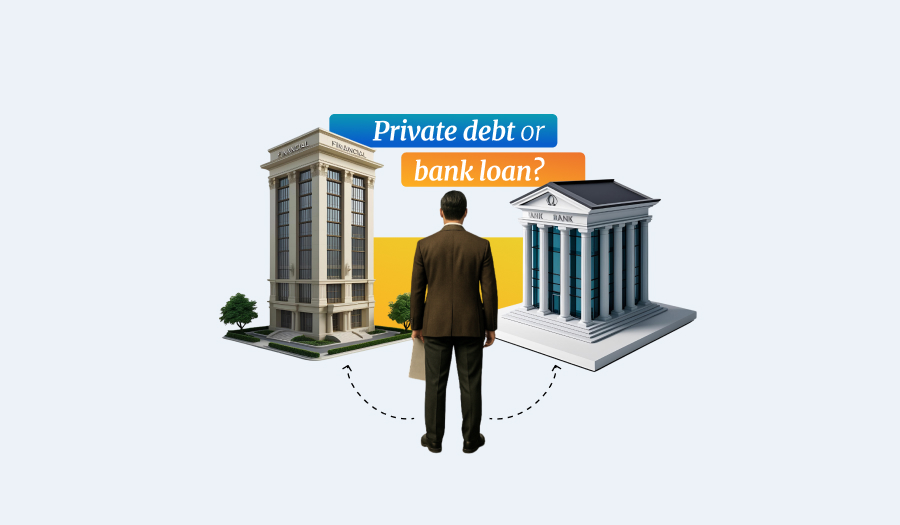Table of Contents
Why Private Debt is in the Spotlight
The Upside of Private Debt
The Hidden Costs and Cautions
Economic Headwinds: A Word on Interest Rates
Smart Steps Before You Borrow
Leveraging AbroadWorks to Mitigate Financial Strain
Final Thought: Private Debt is a Lever, Not a Lifeline
Contributors

Tiny Manyonga
Contributor
- Traditional lending is tightening due to inflation and interest rate pressures
- Private debt offers speed and flexibility, but at higher costs
- Pros include no equity dilution and accessible terms for underbanked owners
- Risks include high interest rates, contract complexity, and limited transparency
- Strategic borrowing and legal advice are essential
Private debt is often viewed as the nimble entrepreneur’s shortcut to capital. However, its growing popularity reflects fundamental changes in how businesses access financing, particularly as traditional lenders pull back. Since the 2008 financial crash, banks have been steadily retreating from small business lending. Even with reforms in place, risk-averse behavior still dominates, pushing banks toward larger, more stable clients.
According to the Federal Reserve and Cleveland Fed, small firms today face more scrutiny, stricter collateral requirements, and lower approval rates compared to previous decades. Furthermore, new academic research suggests that small businesses are often crowded out of credit markets when macroeconomic risks rise, leading to persistent funding gaps (Journal of Financial Intermediation). Layer in inflation, potential interest rate hikes, the threat of recession, and the risk of sustained trade wars, and it becomes clear why many business owners are exploring private debt. Still, this form of financing is no panacea. It’s crucial to assess if this route aligns with your venture’s financial health and long-term strategy.
Why Private Debt is in the Spotlight
With the Federal Reserve signaling further rate hikes to curb persistent inflation, it is expected that traditional business loans will become harder to secure and more expensive in 2025 and beyond. Regardless, private debt’s rise predates today’s economic headlines. Even before the recent economic turbulence private credit was on an upward trajectory. Industry analysts and financial reports have noted a decade-long expansion of the private debt market, driven by institutional investors seeking higher yields and the tightening of post-crisis banking regulations (PitchBook, S&P Global).
According to Preqin, the global private debt market reached an estimated $1.7 trillion in assets under management in 2023, highlighting its increasing appeal. Looking ahead, the market is projected to surpass $2.8 trillion by 2028 (Allied Market Research). Private lenders are filling the gaps left by risk-averse banks, offering more flexible options to underserved small businesses. Many entrepreneurs are turning to these lenders who promise quick access to capital, fewer bureaucratic hurdles, and customized loan terms.
In truth, private debt can be lifeline for businesses struggling for capital. If, and only if, used wisely. Before you jump into the deep end, it’s critical to weigh the pros and cons, since with great financial flexibility often comes greater financial responsibility.
The Upside of Private Debt
- Fast Approval, Quick Funds
Private lenders can often approve and disburse loans in days rather than weeks. For businesses facing urgent payroll, inventory, or operational needs, this agility is a game-changer. - Flexible Terms
Unlike rigid bank products, private loans can be tailored to fit your business model. This includes customized repayment schedules, innovative interest structures, and collateral flexibility. - No Equity Sacrifice
Private debt does not dilute ownership. Founders keep control and avoid giving up a stake in their business. - Accessible for the Underbanked
Entrepreneurs with lower credit scores or operating in high-risk sectors often find more open doors with private lenders.
The Hidden Costs and Cautions
- Expensive Borrowing
Flexibility comes at a price. Interest rates can significantly exceed those of banks, and may include additional origination and exit fees. - Lack of Transparency
Unregulated lenders might obscure key terms. Contracts may hide prepayment penalties or include restrictive covenants. - Too much, too soon
It’s easy to borrow more than your business can sustainably repay. Late payments or revenue dips can spiral into financial distress. - Legal Complexity
Contracts can be dense and difficult to interpret. Without legal review, you may overlook terms that affect your operations or asset ownership.
Economic Headwinds: A Word on Interest Rates
The macroeconomic environment matters. With the Federal Reserve committed to controlling inflation, small business owners must consider how rate increases affect variable-rate obligations. Rising interest burdens can choke cash flow and derail growth plans, especially for already leveraged businesses.
Compounding this, increased borrowing costs can have a ripple effect throughout the supply chain. Vendors and partners facing their own financial constraints may alter payment terms or pricing structures, impacting your operational stability. Even if your business maintains a stable revenue stream, disruptions from partners could lead to cash flow mismatches or require emergency financing, further deepening reliance on high-interest debt. It underscores the importance of planning not just for internal financial resilience, but also for external shocks that may arise in a tightening economic landscape.
Smart Steps Before You Borrow
Before committing to private debt, it’s essential to evaluate your business’s resilience and its long-term strategic goals. Begin by assessing whether your company could still manage its debt obligations if there were a significant dip in revenue, say, a 20% drop. This kind of stress test can reveal your financial buffer and highlight potential vulnerabilities.
Next, ensure you have a full understanding of the loan agreement. Every clause, from interest rates to repayment schedules and penalties, should be crystal clear before signing. Many businesses fall into financial traps not because of bad intentions, but because of misinterpreted or overlooked terms.
Additionally, consult with a financial advisor or a business attorney. These professionals can provide critical insights into the long-term implications of the loan and help you identify red flags that may not be obvious at first glance.
Finally, consider whether you are using long-term debt to solve a short-term problem. While it might be tempting to plug a temporary cash flow gap with a multi-year loan, doing so can create a mismatch that burdens your business long after the issue has passed.
Leveraging AbroadWorks to Mitigate Financial Strain
In the face of tightening credit and rising operational costs, small businesses can explore alternative strategies to maintain financial health. AbroadWorks offers comprehensive global employment solutions that can help reduce overhead expenses:
- Cost-Effective Staffing: Access a global talent pool to hire skilled professionals at competitive rates, potentially lowering labor costs without compromising quality.
- End-to-End Hiring Solutions: From vetting candidates to managing payroll and compliance, AbroadWorks streamlines the hiring process, saving time and resources.
- Flexible Workforce Management: Scale your team up or down based on business needs, providing agility in response to market fluctuations. Make the most of your team using proven management practices.
By integrating AbroadWorks’ services, businesses can alleviate some financial pressures that might otherwise necessitate private debt financing.
Final Thought: Private Debt is a Lever, Not a Lifeline
Used strategically, private debt can be a catalyst for business agility and growth, providing critical capital when traditional avenues fall short. But it is not without peril. The allure of fast funding and flexible terms must be tempered with a deep understanding of the costs, risks, and long-term implications. In a climate of tightening credit, economic uncertainty, and rising interest rates, the businesses that thrive will be those that borrow with intention, backed by solid financial strategy and expert legal guidance. Private debt is a powerful tool, but only in the hands of those prepared to wield it wisely.
Sources:
Preqin (2023). Private Capital Market Update
Federal Reserve (2025). Monetary Policy Overview
Bloomberg (May 2025). Powell Says Persistent Inflation May Force Rate Hike
Cleveland Fed (2013). Why Small Business Lending Isn’t What It Used to Be
Journal of Financial Intermediation (2022). Small Business Credit and Macroeconomic Risk
PitchBook (2023). Private Debt on the Rise
S&P Global (2021). Private Credit on the Rise
Allied Market Research (2023). Private Debt Market Outlook
